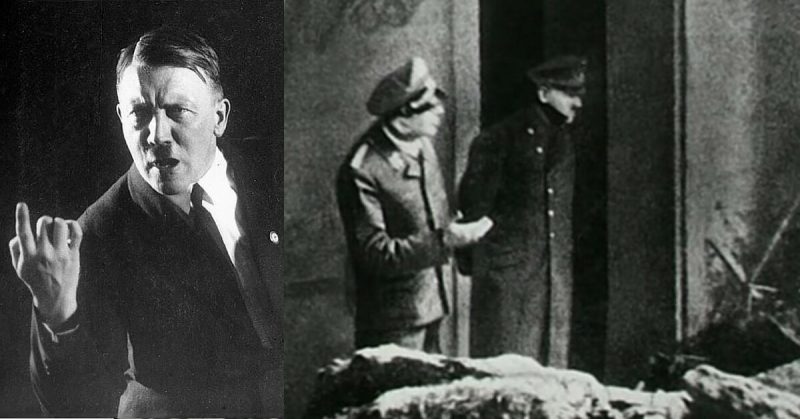It takes some serious soul-searching to make the final decision to end your own life – especially when you’re the leader of the Nazi Regime during a major world war. But everyone must pay a price for their actions, and Adolf Hitler had certainly reached his limit after inflicting his own brand of terror upon the world.
At one point in time, Hitler’s horrifying abuse of power was the only thing on everyone’s mind. Every person was forced to watch or flee the devastation of the Nazi regime’s control, never being able to truly escape the impact of the evilest regime the world has seen to date.
But as the tyrannical leaders of the second world war began to lose their grip, and their plans began to unravel in the face of worldwide opposition to their cruelty, hard choices soon had to be made. And Hitler’s solution to his downfall was to simply erase himself from the equation, going out in his version of a blaze of glory.
The Events Leading up to His Inevitable Fate
By the start of 1945, Germany’s military forces were falling apart, and the country itself was surrounded by the enemy on all sides. The Soviet Union had gained control over Poland in order to make their way to do the same with Berlin; the British and Canadian troops had crossed the Rhine and were making their way into the industrial center of Ruhr, and the American front in the South was invading upwards towards Mannheim and Mainz.
As all of these combined efforts were forcing the German offensive to crumble, by February, meetings between the Allies were being held to discuss putting an end to the war in Europe. By this time, however, Hitler had already been preparing for the end as well.
In January, once the Third Reich had all but disintegrated, Hitler began to retreat to his Fuhrerbunker, his safe haven in Berlin. From his hiding place, he was still making demands on his fellow Nazi officers to carry out operations to hold back the Allies.
Despite his best efforts, there was no stopping the sheer force of the manpower heading their way. By April, instructions to SS General Felix Steiner to bring in a force to rescue Berlin were never carried out, and Hitler fell into an almost nervous breakdown due to what he deemed the incompetency of his officers. At this point, Hitler had come to the realization that his war was actually lost.

And on that same day, the Fuhrer had started making arrangements for his suicide. His plan was to remain in Berlin, and ultimately shoot himself when the time was right.
Calling in his physician, Dr. Werner Haase, Hitler asked his advice on the best method for pursuing his plans for an early death. Hasse mentioned the pistol and poison method, whereby Hitler would have to combine a capsule of cyanide with a shot to the head. He took the doctor’s advice, and the plan for his suicide was in place.
The Final Moments
By the end of April, Hitler caught wind of his commanders no longer following his orders. On April 29th, 1945, Hitler decided it was time to prepare his final decisions, and the first step was marrying his longtime love Eva Braun in a small ceremony just after midnight, hidden away in their bunker.
Following their first breakfast as husband and wife, Hitler constructed his final will and testament with his secretary. The end details of his life were all in order by 4 am that morning, and the only move left was to go through with his suicidal mission.
On April 30th, the day which would become his death day, the Fuhrer still continued to receive word about his surroundings. He was informed that Berlin was indeed under siege and that the fighting would undoubtedly be over within 24 hours.
The Soviets were closing in on their location and were actually as close as 1,600 feet away from the bunker itself. The end was near, and Hitler knew it.
Witnesses within the bunker reported hearing the gunshot at 3:30PM.
Heinz Linge, Hitler’s valet, opened the door minutes later to find both bodies dead on the sofa. Smelling burnt almonds, a common indicator of the presence of cyanide, Linge presumed that the poison had been ingested.
Later, this was found to be the cause of Eva’s death – biting into a cyanide capsule. Hitler, however, was found slumped over, blood pouring out of a gun wound in his right temple and onto the sofa fabric. He had dealt himself the final blow with his own gun, a Walther PPK 7.65.
The Fuhrer had been pronounced dead, and the bodies of both Hitler and Braun were carried from the bunker to the garden of the Reich Chancellery, where they were doused in petrol oil and set ablaze. The remaining officers and staff, including Linge, Reich Minister of Propaganda Joseph Goebbels and his entire family, secretary Martin Bormann, and more gave the married couple a final salute as the bodies burned.
Multiple attempts to burn away the corpses so they would be completely unidentifiable were made, and the fellow officers finally decided to move and cover the bodies in a shallow bomb crater nearby.
After these events, the Soviets had finally swept into the city of Berlin, and the fighting was coming to an end. And the rest, as they say, is history.
Despite these details, Hitler’s death still remains a conspiracy to many, as the remains were considered unverifiable to some experts. The few remaining bones and skeletal fragments (that were tested countless times) have repeatedly been deemed inconclusive.
Therefore, Hitler’s suicide still carries an air of mystery, adding to the dark and disturbing era of his reign.
